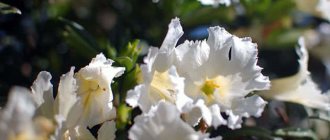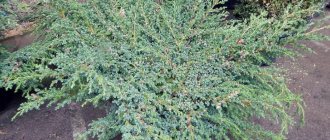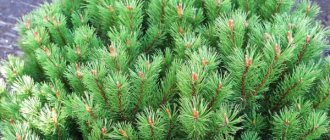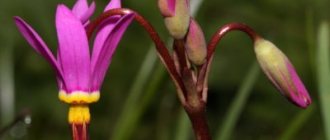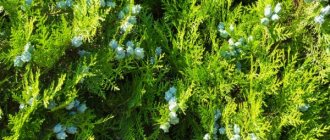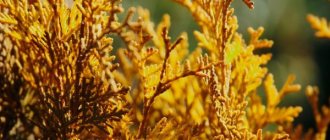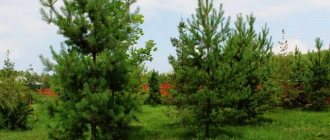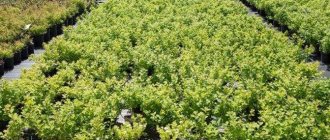Description of the variety
Pumilio mugo pine (pinus mugo pumilio) is a dwarf subspecies of mountain pine (pinus mugo). Its main difference is its bush-like dwarf form. An adult tree reaches a maximum height of 1.5 m, the annual growth is 2-5 cm. The needles are rich green, the length of the needles reaches 5 cm. Cone-shaped cones adorn pine trees that have reached 7 years of age. A distinctive feature of the Pumilio pine is the shape of the crown. Young growth grows vertically upward, and with age the branches descend to a horizontal position under their own weight. The crown diameter can reach 3 meters. The branches of the plant are densely located, so the pine tree looks neat and compact. The size of an adult pinus mugo var pumilio tree is almost twice as wide as it is tall due to its creeping form.
Description of the plant
In the wild, mountain pine pumilio or pinus mugo grows on mountain slopes in eastern and southern Europe. The plant looks like a low-growing coniferous shrub with a dense crown. The height does not exceed one and a half meters. Since the plant is creeping, the width of the crown can significantly exceed the height.
Pine is characterized by extremely slow growth. In a year it grows no more than 4-5 cm. It will take 30 years to reach a meter in height. The needles have a rich green color and are collected in 2 pieces. The length of the needles and the size of the cones are from 3 to 5 cm. The cones appear at 7-8 years of life and have the shape of a cone.
At first, the branches of Pinus mugo Pumilio grow vertically, but gradually bend downwards under their own weight and spread out on the ground. Numerous branches form a dense compact bush. The roots are well branched and go shallow into the soil.
Mountain pine is unpretentious. Even the high pollution of urban areas is not harmful to it. Landscape designers use this.
This plant is often planted near large buildings and on roofs. The crown of the bush is easy to shape and can be given the most bizarre shapes.
The advantages of the Mugus Pumilio species are:
- Resistant to low temperatures and strong winds.
- Unpretentiousness and ability to grow in any soil.
- Possibility to form any crown.
- Easy to grow and care for.
Spreading
The homeland of the mugo pine Pumilio is the mountains of Central and South-Eastern Europe, where this species creates impenetrable thickets, which actively prevents avalanches and soil erosion. The root system of Mugo Pumilio is well developed and highly branched, reliably strengthening the soil on which it grows. Thanks to this property, the Pumilio variety has high wind resistance. Pine is unpretentious to growing conditions. Tolerates cold and heat well, lack of moisture. In urban conditions, it absorbs harmful atmospheric impurities, purifying the air and saturating it with oxygen.
Planting and care
The unpretentiousness of pine and its compact shape have made it popular in landscape design. Caring for a tree is not particularly difficult, but you still need to follow the basic rules.
To plant a pine tree, you need to choose a well-lit, open place, since the pine tree will not grow in the shade. It is best to purchase a seedling from a specialized nursery, which guarantees compliance with the declared variety. The seedling should be 3-5 years old. This is the most optimal age for settling into a new place. When choosing a seedling, you need to pay attention to its appearance. The root system should be closed, the needles should be bright green, without yellowed needles or brown spots on them. The seedling must have a healthy, fresh appearance. The optimal time for planting is May or September.
Pumilio pine is unpretentious to the soil composition, but for better growth it is recommended to use a soil substrate consisting of the following components: turf soil, leaf humus, clay and sand. The hole for planting a seedling should be twice the volume of the plant root.
Initially, a drainage layer consisting of fine gravel and sand is poured into the planting hole. A hump of soil is made in the center of the hole, on which the seedling is placed, spreading the roots around the hump. After this, the root system is covered with a nutrient substrate and compacted. The root collar should be 1 cm above the top layer of soil. The soil around the seedling is mulched with peat and watered abundantly. Mulch will keep the roots from drying out and from freezing in winter.
If Pumilio pine is planted in a group, then the distance between the bushes should be at least 2 meters.
Care after planting a pine tree consists of watering and loosening the soil. During the dry summer months, young Pumilio pine needs to be watered 2 times a month. The volume of water per plant is 10-15 liters. Mature trees are watered only in exceptional cases; during the period, young seedlings must be fed with mineral fertilizers for conifers; organic matter is a good alternative. After the plant reaches 10 years of age, it does not need to be fed.
In winter, it is advisable to tie the bush in a bundle to avoid deformation in case of a large amount of snow or ice.
Landing rules
It is not difficult to grow these needles on the site; the main thing is to choose high-quality material, plant it correctly and provide the necessary care.
Selection of seedlings
You can buy this plant in a specialized nursery or in a gardening store, the main thing is that it meets all the withered characteristics of the variety.
When choosing, carefully inspect the above-ground part - one should be alive, the shoots and trunk with even and smooth bark, the needles a uniform rich green color.
The optimal height of a seedling for planting is 50-70 cm. It is better to take bushes 2-3 years old with closed roots, which will not dry out during transplantation to the site.
Place and soil
Pumilio pine likes to grow in a sunny location with deep groundwater and protection from drafts.
Light, loose soil is suitable - sandy, clayey, siliceous with a neutral level of acidity and a low degree of salinity. In shady areas on salty soil, the plant begins to weaken its immunity against disease and grows slowly.
This variety tolerates gas and dust well, so it can fully develop both in the garden and outside, along roads.
To deoxidize the soil, 300 g of limestone, chalk, dolomite or calcite must be added to a 1 m² bed. Sand and peat - 2 buckets each - will help make it loose and light. To increase nutritional value, additionally sprinkle the bed with 100 g of superphosphate, 80 g of potassium nitrate and 70 g of azophosphate. Then deep digging and leveling are carried out.
Landing technique
This compact plant should be planted according to the scheme - 1x1 m.
First, they dig holes 60 cm deep and 80 cm wide. Then drainage from pebbles, crushed stone or broken brick is laid at the bottom, then filled to half with a nutrient composition of sand, peat and turf soil (1: 1: 1). They lower the earthen ball, fill all the voids with fertile soil, compact it and spill it generously - a bucket per seedling.
When planting, it is important that the root collar of the bush is slightly above the surface of the soil, otherwise it will quickly rot and die.
To prevent rapid evaporation of moisture, the tree trunk area is mulched with peat soil or pine sawdust.
Reproduction
Mugo pine Pumilio, like other conifers, can be propagated by seeds, grafting and cuttings.
For propagation by seeds, it is necessary to immediately create special conditions. To do this, prepare seedling boxes and pour a nutritious, light and loose substrate into them. The seeds are pre-soaked in a solution of foundationazole or phytosporin, after which they begin sowing. Each seed is placed in the soil to a depth of no more than 0.5 cm, at a distance of 5 cm from each other. The soil is moistened with a spray bottle, covered with a film to retain moisture and placed in greenhouse conditions.
Sprouts begin to appear after 2-3 weeks. After germination, you need to remove the film and maintain humidity by watering the soil and spraying the sprouts with a spray bottle. Seedlings can be transferred to open ground no earlier than after 2 years, being careful not to damage the delicate root system.
Cuttings are the simplest and most effective method of pine propagation. This method completely preserves the varietal characteristics of the mother plant. Cuttings are usually carried out in the spring. To select cuttings, a healthy tree is selected; cuttings are cut from last year's young shoots. The length of the cutting should be approximately 10 cm. It is cut off with a sharp knife along with the heel - part of the bark of the mother shoot. Cut cuttings are placed in a weak solution of potassium permanganate to get rid of a large amount of resin released at the cut site. After this, the cuttings are transferred to a growth stimulator solution for 12 hours.
For planting, prepare an earth mixture consisting of equal parts of turf soil and sand. A drainage layer is poured onto the bottom of a special container, and an earth mixture is placed on top. Prepared cuttings are planted in the ground to a depth of 4-5 cm, with an interval of 10 cm from each other. The soil is compacted and moistened, the container is covered with glass or film, and moved to a warm, bright place, creating greenhouse conditions. Rooting occurs throughout the year. A rooted cutting can be recognized by its fresh green tip. Throughout the year, caring for the cuttings consists of carefully loosening the soil after watering. In summer, it is advisable to feed the cuttings with special mineral fertilizers (“Agrecol”, “Novofert”). Rooted plants are planted in a permanent place the following autumn, if cuttings were carried out this spring.
Diseases and pests
Pumilio pine has good immunity to diseases and pests, but still, it may not resist some of them. This can occur under unfavorable growth conditions or mechanical damage.
The most common pine diseases are: rust, fusarium, powdery mildew, spinner, schutte, and cancer.
Symptoms of the disease manifest themselves in changes in the appearance of the plant. The pine tree changes the color of its needles to pale or yellow, warts and ulcers appear on the trunk, and the branches begin to become deformed or become bare. Most diseases are caused by fungal infections. If the fight against diseases is not started in time, the tree may die. To treat diseases, it is necessary to remove foci of infection and treat the tree with fungicidal drugs, such as foundationazole, Bordeaux mixture, zineb, polycarbacin, carefully following the instructions for these drugs.
Pine is attacked by insect pests. The most common: cutworm, aphid, bark beetle, hermes, spider mite. Pests weaken the tree, pine loses its decorative effect and takes on an unsightly appearance. Pests eat young needles and damage the buds, causing Pumilio to stop growing. When attacked by aphids, the needles curl and dry out. To control pests, insecticides are used, which are sprayed on the tree in spring and autumn for prevention, as well as when pests are detected. These are the drugs “Lepidotsid”, “Talstar”, “Karbofos”, “Decis”, “Enzhio” and others.
Features of care
Mountain culture is resistant to lack of moisture. It needs abundant regular watering only for the first time after planting. If the pine tree was planted in the fall, it needs to be watered for a month, and if in the spring, the soil should be moistened before summer begins.
If the autumn is dry, abundant autumn watering is necessary. It needs to be repeated several times. This will avoid frost damage to the bark and ensure a safe winter. The soil must be saturated with water to a considerable depth.
In nature, pinus mugo var Rumilio grows on stones or very poor soils, so it does not require additional feeding. You can add a little fertilizer in the first years after planting to help the plant take root better.
A healthy bush that is not affected by pests is fertilized for up to 10 years, then it is stopped. This rule applies if the seedlings are at least 4-5 years old.
When planting in a hole, you can add starting fertilizer. This will allow you to avoid fertilizing for the next 2-3 years. In the northern regions, pine must be fertilized in the fall. Potassium and phosphorus compounds are added to the soil annually. This will increase the plant's resistance to frost.
Foliar feeding will be useful for the shrub. This way the plant receives additional microelements that are poorly absorbed through the root system.
Every 2 weeks you can spray the needles with a chelate complex. Green needles respond well to magnesium sulfate. This will increase the plant’s resistance to diseases and adverse environmental factors, as well as improve its decorative qualities.
During the first 1-2 years after planting, the soil must be loosened periodically. Then it is better to replace the procedure with mulching - this prevents injury to the roots, protects the soil from drying out and provides a favorable microclimate.
Sanitary pruning should be done before the buds open. Remove all damaged and dry branches. It is important that there are no dead shoots left inside the crown.
Use in landscape design
Thanks to its unusual appearance and compactness, Pumilio pine is popularly used in landscape design. In addition, the reason for its popularity is the plant’s ability to release phytoncides that are beneficial to health, and to absorb harmful fumes produced by industrial enterprises and cars.
Pine feels great in decorative containers that can be moved from place to place, changing design decisions. This plant serves as a decoration for summer areas, balconies, loggias and verandas.
In open ground, pine looks good on rocky hills in combination with other conifers. It can be an element of garden compositions among flowering plants. Depending on design decisions, dwarf pine is planted along paths, fences, and at park entrances. It looks great in rock gardens and Japanese gardens.
The unpretentiousness of the plant, its compact and attractive appearance, and beneficial properties have made the Pumilio pine a favorite among gardeners and designers who are happy to plant this tree, decorating their garden plots and landscape interiors of cities.
Types of mountain pine
This beautiful evergreen dwarf shrub has a variety of species:
Winter Gold - pine is distinguished by the fact that it changes its green color: in winter it becomes golden.
- Pug - its characteristic feature is the spherical shape of the crown.
- Brevifolia also differs in the appearance of its crown; it has a barrel-shaped shape.
- Hampi - its crown is spherical with a diameter of 1.4 meters, and the height of the bush is no more than 90 centimeters.
- Ophir, dwarf pine. Its height is only about 35 centimeters, the needles have a golden hue, and the crown grows in the shape of a pin.
Descriptions of the mountain pumilio pine and its varieties show that the variety of shapes and colors of this evergreen shrub allows you to create beautiful decorative landscapes.
